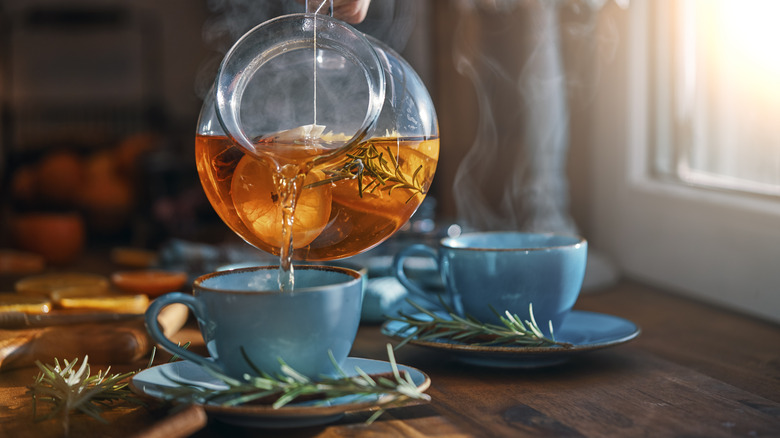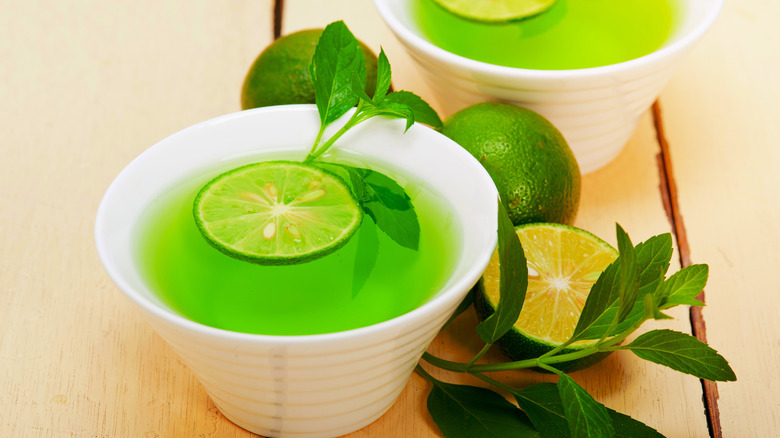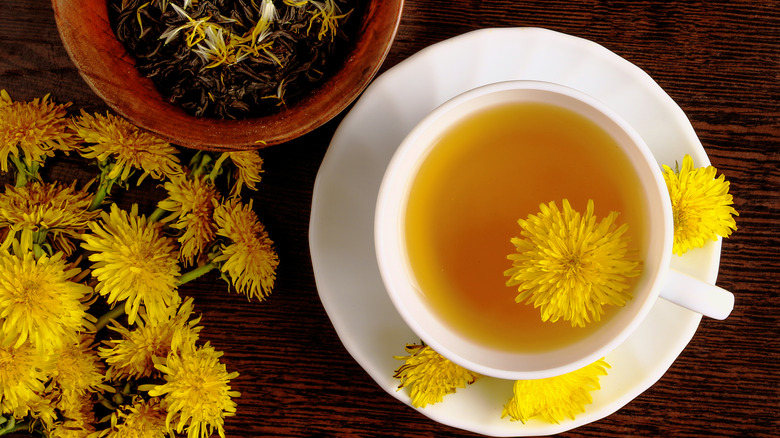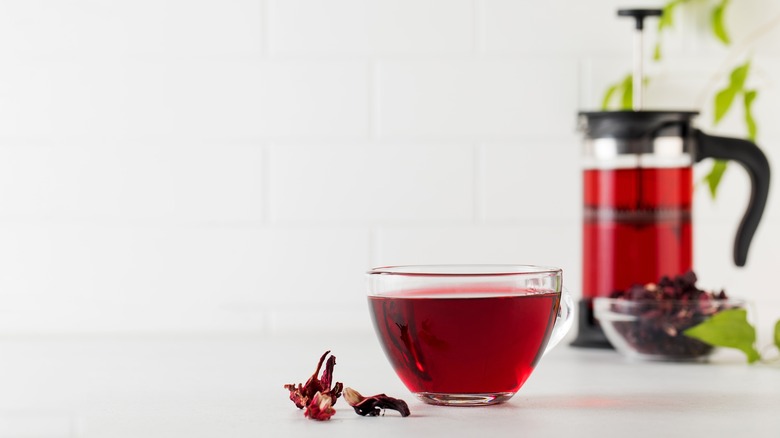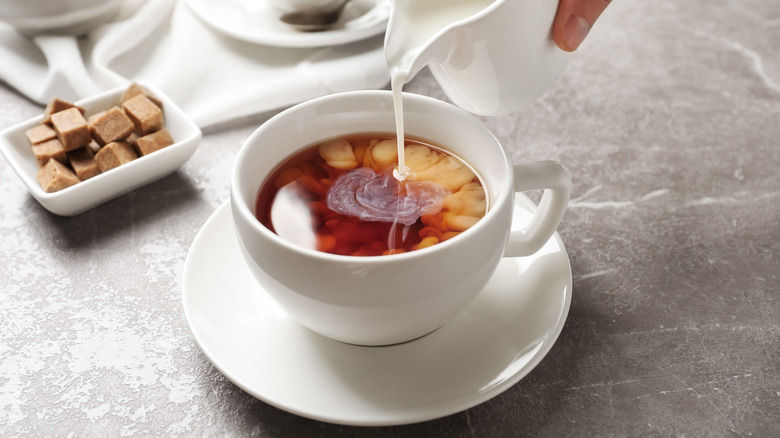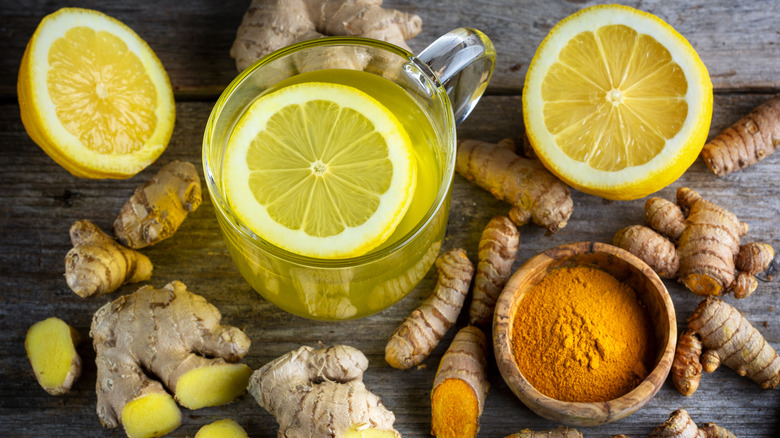Tisane Is The Herbal 'Tea' Type You Should Know
Turns out you're probably already very familiar with what a tisane is and most likely have a box or two of them hanging out in your pantry. Simply put, a tisane is what we know as an herbal tea. If you're a fan of them then you're well aware of how their varieties run the gamut and are stacked from floor to ceiling at the grocery store. We tend to lump tea and herbal tea together, but there's one big difference between the two aside from what time of day you tend to sip on them.
What delineates a tisane from a tea is what it's made from. Tea is brewed from the leaves of one particular plant, whereas a tisane is an infusion of different parts of one or many plants. In that sense, something labeled "herbal tea" is a misnomer — anytime you steep a bag of herbs, seeds, etc. in water, it's technically a tisane.
While the tea patrol isn't going to come after you for referring to a tisane as a tea, it's worth learning more about the beloved botanical infusion.
What is a tisane?
"Tisane" is derived from "ptisanē," a Greek word for barley water — a crushed pearl barley infusion, if you will. And that's simply what tisane is: an herbal infusion. Nowadays, tisane is the more legitimate term for what we know as herbal teas such as chamomile, peppermint, and hibiscus.
Tisanes are made from fresh or dried parts of plants, including their leaves, seeds, stems, bark, roots, and flowers. Pretty much any component of a plant or herb is considered a tisane if you add it to water and let it permeate. They're enjoyed either hot or cold, though much like tea, the steeping is done in boiling or simmering water.
There are two methods of preparing a tisane: infusion and decoction. Infusion is the traditional method — steeping in hot water like traditional tea. Boiling water is poured over the plant parts, and they are given time to saturate the water. Decoction involves submerging the plant parts in boiling water and allowing their essential oils to infuse the water over a longer period of time — up to 45 minutes. The general rule of thumb is that any plant part with a hard surface (such as a root) is decocted, whereas softer, larger leaves and flowers are infused.
Origins of tisane
Tisanes are enjoyed across the globe and have been used therapeutically and for celebrations and rituals for centuries. The first tisane in the books goes back to ancient Egypt and was a cup of chamomile meant to calm you and honor the gods.
While the etymology of "tisane" is widely accepted to be derived from the Greek word "ptisanē," it is also believed to have French and Latin roots. Both are interpretations of the word "tisane" being broken down into "tea without tea." All in all, the consensus is that a tisane is made from anything but tea leaves.
Tisane is believed to have taken off in popularity in the United States during the Revolutionary War. As a defiance of the taxation on traditional tea leaves, Americans started brewing "freedom tea" made from local herbs that were not subject to fees. And while Native Americans had been making dandelion tisanes long before this, these herbal alternatives are thought to be the source of the word "tea" taking over the meaning of tisane.
How different varieties of tisane are made
There are generally several varieties of tisane depending on what part of the plant they come from: leaf, root and spice, fruit and berry, flower, and bark.
Leaf tisanes are probably the most similar to traditional tea in appearance. Peppermint, lemon verbena, rooibos, and yerba mate are popular varieties. They are steeped like conventional leaf tea with the infusion method. Spice tisanes include the popular cardamom, fennel, chicory, and licorice varieties. They are often on the stronger end of the spectrum in taste and are usually balanced with ginger root for sweetness. Fruit and berry tisanes are sweet — they include fruit pieces and leaves and are usually combined with spices, vanilla, or citrus to enhance their flavor. Raspberry leaf is a popular one, as are peach, apple, and blueberry varieties; berry tisanes are usually decocted. Hibiscus, chamomile, lavender, and rose hips are some of the most popular flower tisanes. Flower tisanes are almost always very aromatic and are also infused like leaf tisanes. Bark tisanes include the beloved cinnamon as well as slippery elm and are usually decocted.
Tisanes come bagged or loose-leaf, or you can play around and make your own combination. Steeping time and method will depend on what part of the plant you're using.
How tisane differs from tea
There are a few main differences between a traditional tea and a tisane. To be considered a true tea, the leaves must come from one plant only — Camellia sinensis, which is part of the Theaceae family. Green tea, black tea, white tea, and oolong all come from it. Anything made from this plant is considered a tea in the traditional sense, and no part of any tisane comes from this shrub.
Another marked difference is the presence of caffeine. The amount of caffeine in true tea varies quite a bit, but with the exception of yerba mate, all tisanes are caffeine-free. Tisane should also never be made in an aluminum pot — some plants may react with the metal, resulting in a toxic drink.
Aside from those two main variances, both true tea and tisanes are prepared in a similar manner, can be enjoyed sipped warm or over ice, and welcome the addition of a sweetener. However, milk is rarely added to tisanes as the presence of fruit can cause curdling.
Purported health benefits of tisanes
Tisanes have been used for thousands of years to appease common ailments. If you've ever sipped on ginger tea while nauseous or a fennel infusion to cure indigestion, you've experienced their settling properties. Cardamom seeds are often offered at the end of some meals to help appease gas and bloating, and a tisane steeped from them can serve the same purpose.
Chamomile tisane popularly comes with a bear in a nightcap on the box to indicate its relaxing properties. Cinnamon has also been touted to help lower blood sugar levels and at the very least offers up a satisfyingly sweet post-meal sip (per Heathline).
According to Penn Medicine, hibiscus tisane helps lower blood pressure and keep your liver healthy. Peppermint tisane may relieve migraine pain, and rooibos has a positive effect on cholesterol levels.
It's important to keep in mind tisanes are often a blend of many ingredients. Always check the label to ensure you have no allergies, and steer clear of those marketed as a quick weight loss fix or detox.
